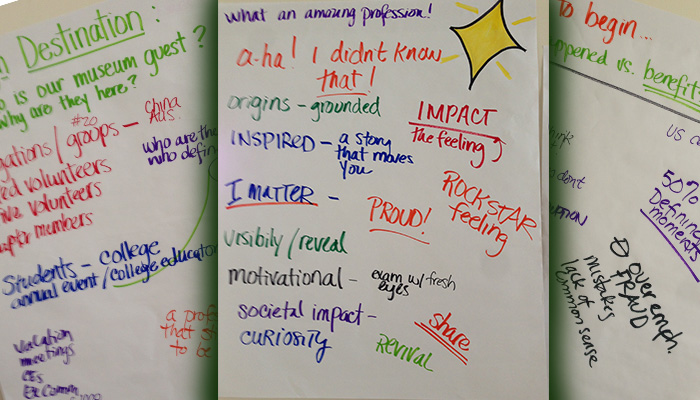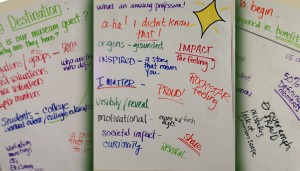Design Kickoff Meeting – Putting our assumptions to the test and finding the right voice for the story
This is the third article in a series about designing and building the Museum of Internal Auditing in eight months. The previous article explains how and why we developed an Exhibit Plan for the museum. This article is about how we started the design process with a Design Kickoff Meeting.
At this point we have established that museum is a necessary project that we want to help make a reality. We developed an exhibit plan that described how we are going to approach telling this story as well as establishing schedules and budgets. Our client is happy with the direction so far and it is time to move forward with the designs.
We like to start the design process by holding a Design Kickoff Meeting. There are a lot of reasons why this is important. We want to make sure that this entire community of people who are embarking on a complicated process are all starting from the same place. We want to give everyone specific direction on what they can do to help the process and we want to establish roles and some boundaries. Getting everyone in the same room is the best way to do all of that.
Before the meeting we distributed a copy of the Exhibit Plan and generated a survey to help us prepare for the meeting. The survey is designed to accomplish three things. First, it serves to open up the conversation and give people who may be shy in a meeting the opportunity to tell us what is important to them. Second, it gives stakeholders a sense of where we want the conversation to go, that at the meeting we will be focusing more on what we are going to accomplish and not how we are going to accomplish it. And finally it gives us a clearer picture of how they are thinking about the project and sometimes reveals conflicting goals within the group that we need to address.
The main purpose of the meeting is to build consensus and use that consensus to give clear direction to our design team. We want to make sure that we have the story right and that we are going to tell it in a way that communicates a clear message.
Our own Marilee Emerson facilitated the meeting. It lasted almost two hours and seemed to go by in a flash. As the conversation continued, Marilee recorded it graphically which helped everyone follow the conversation and gave us a record of what we discussed. These recorded pages will then be hung on the walls of our design studio so that we can refer to them and make sure that the designs continue to match the desired outcomes.
One of the more important images to us as a design team is one we call the North Star. This identifies the desired outcomes for a visit to the museum. Throughout the meeting, whenever we identify something that is an important outcome, Marilee will record it on the North Star. As we work on the narrative and design later, we can look up and make sure that we stay true to these desired outcomes.
As they defined the museum guests and continued developing the North Star, it became clear to me that our narrative approach didn’t match with the desired outcomes. The space is small and we needed to focus more on why internal auditors and internal auditing is important in all our lives. We had taken more of a historical survey approach and it had left us without enough space for what is really important. Not to worry though, about half of the narrative was working well, we just needed to change the focus of the other half. That is why we have this meeting.
The meeting ended too soon and we were all left to our tasks. Marilee always ends these meetings by asking them to describe their experience with the meeting and the process in one word. We heard amazed, overwhelmed, and excited. We all left the meeting knowing that there was a lot of work left to do, but we knew what our next steps needed to be and we were all excited for the future of the Museum of Internal Auditing.
This is the third post in a multi-part article about the process of designing and building the Museum of Internal Auditing in only eight months. In the next article, we will look at design concepts and start to see what this museum will look like. If you want to read more about this process, you can use the following links:
Building a Museum in Eight Months – Part 1
Building a Museum in Eight Months – Part 2
The quest for easily accessible mental health resources has led many to explore Lexapro Over the Counter as a potential solution. Lexapro, known for its ability to regulate mood, can play a significant role in managing symptoms of depression and anxiety. Nonetheless, the importance of medical guidance cannot be overstated, as proper dosing and monitoring are essential to safely benefit from this medication. Lexapro over the counter
In the realm of mental health treatment, the availability of medications like Lexapro Over the Counter is a topic of much discussion. While having access to such medications could enhance the availability of mental health support, it also raises concerns about the responsible use and potential risks of self-medication. As such, it’s imperative for individuals to seek professional advice and thoroughly research any medication before use.


